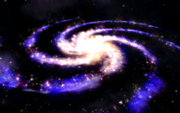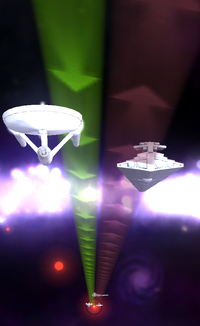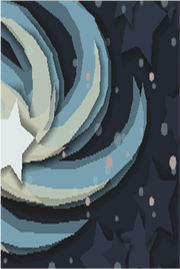
|
Spore Galaxy is a Featured Article
"Spore Galaxy" has been featured, meaning it was deemed an article of interest by the Community.
|

The Spore Galaxy, most commonly referred to as The Galaxy, is the setting of the Spore games and forms the playable area in the Space Stage. It contains 42,010 visitable Stars, all with up to 8 orbiting planets (5 terrestrial planets and 3 gas giants). The number of planets is randomly determined, for a total of approximately 150,000 planets (or 120,000 terrestrial planets). The galaxy is seen through the Galaxy View, which can zoom out to see progressively larger portions of it.
Structure

The Spore Galaxy is an unbarred spiral galaxy with five arms extending out from the Galactic Core, a supermassive black hole at the center of the galaxy; the galaxy contains many other black holes (all of which are connected wormholes), along with other less common galactic formations such as Nebulae and Proto-Planetary Disks. The most common features, and the ones that make up most of the structure of the galaxy, are regular stars. Most stars are within the galactic arms or close to the Core, but some can also be found away from the main disc of the galaxy, far beyond the reach of even Interstellar Drive 5. There are three main types of stars available - red dwarfs, yellow stars, and blue giants, which will appear separately or in binary pairs containing mixtures of stars.
The most noticeable features in star systems are planets. Many of these planets are inhabited, although most planets are barren with no life until you begin terraforming it. Some planets also have moons orbiting them. Moons are most commonly found orbiting gas giants, and there will always be a moon orbiting a save game's homeworld; comets and asteroid rings also appear in many star systems.

When the player's spaceship leaves its planet, and then its star system, the player will find themselves in the very large void of space, however the player is not alone. Using the SETI tool, it is possible to find other inhabited star systems with planets at various stages of evolution. The player can travel to these star systems and planets to make contact with the inhabitants. All the planets, empires, and species discovered are available in the Sporepedia.
Society
There is no singular, dominant culture that defines life in the Galaxy, and is instead made up of the multitude of diverse spacefaring civilisations known as "empires" and their interactions with their neighboring civilisations. Empires typically subscribe to one of ten Philosophies (practically, this will be one of eight, as two of the philosophies -Wanderer and Knight- are only available to the player) that defines their overall attitude and behaviour; philosophies do not tend to change over the course of an empire's existence with exception to rare cases. Each philosophy has a history that is partially told through lost artifacts scattered across the galaxy that explains the rationale behind their beliefs as well as their attitude towards The Grox empire.
Despite the disparate nature of wider galactic society, there are vague notions of a "galactic community", a universally accepted galactic currency in the form of the Sporebuck (§) and a widely agreed upon Galactic Code, similar to the real life Geneva Conventions, that prevents the use of destructive superweapons. Some empires mention a "Galactic Security Force" after Grox attacks, but it is unknown what this is, and the phrase may even refer to the empire's own armed force rather than a galactic one.

The Grox, a unique and highly aggressive empire controlling 2,400 systems around the Galactic Core, is not part of any galactic community and are treated as a menace by all empires in the galaxy.
Races
The galaxy functions as an open sandbox for interacting with other empires. Nearly every star system in the Spore Galaxy is capable of being colonized (except the few stars which are inaccessible), and empires do not appear to be limited by how much they can grow except by the boundaries of the galaxy itself. While most are determined randomly by the computer or downloaded by the player, the Grox are the only fixed empire that has been built into the game and control 2,400 systems around the center of the galaxy. All Maxis creations will pollinate in the galaxy.
Some empires featured in previous versions of Spore, which are mentioned in artifacts:
Trivia

“Oh, well, there will be probably well over a hundred thousand. I mean, far more than a player could ever visit. Which is why there is no point to having another galaxy. If there are going to be thousands of stars in a galaxy there is no way that one person in their lifetime could ever visit them all.”
- - Will Wright
- The sheer size of the Galaxy in Spore makes it difficult (but not impossible) to explore it all, let alone claim even an arm of the galaxy for your empire. Will Wright explained this as being the reason for the number of visitable stars in-game.
- There are two easter eggs relating directly to the Spore Galaxy.
- The first is in the main menus of Spore and the Creature Creator. If you spin the galaxy in the main menu of Spore very fast, a cluster of pictures of the game's producers will appear. If you press CTRL+SHIFT when you see the pictures, you see more of them. In the Creature Creator, doing the same thing causes Will Wright's head to appear.
- The second easter egg is that the player can find the Sol system with Earth and the other planets, excluding minor objects. This means that there is a possibility that the Spore Galaxy is actually the Milky Way, but on the other hand, the structure of the two galaxies is noticeably different.